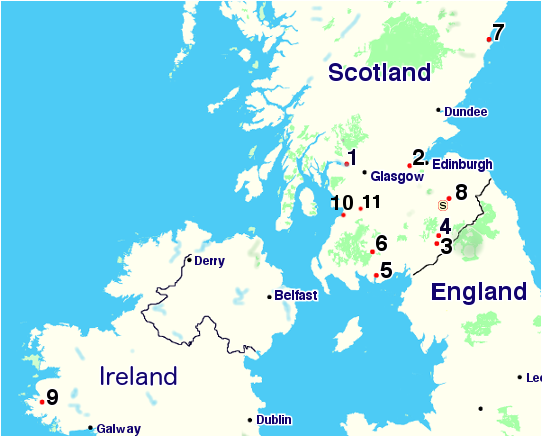Every story must have a first telling, and therefore a first place where it is first told. Few tales either contain or retain a strong connection to any specific location though, and often lose those connection as time passes and the story is retold, particularly as it moves away from its place of origin.
Tam Lin comes from Scotland, and it is therefore not surprising that Tam Lin retains ties to Scotland in the form of the language and imagery present in the tale. However, the tale retains important links to its origins in a number of other ways as well. For one, the tale often mentions noble familes of importance, and therefore more can be learned about Tam Lin by studying Tam Lin and the Families of Scotland
Furthermore, there is one specific region of Scotland that has stronger ties to Tam Lin than any other version. The choice of place names and event locations indicated the strongest ties to Scotland are centered around a specific area in the border regions, and we shall therefore also explore Tam Lin and Carterhaugh.
Source Locations for Versions of Tam Lin

- Dumbarton - source of 39F
F was learned by Widow McCormick from an old woman in Dumbarton: Motherwell's Note-Book, p. 4.
- Kirkhill - source of 39I
I. " The variations in the tale of Tamlane " were derived "from the recitation of an old woman residing near Kirkhill, in West Lothian: " Scott's Minstrelsy, II, 102, 1802.
- Langholm - source of 39I
The Editor has been enabled to add several verses of beauty and interest to this edition of Tamlane, in consequence of a copy, obtained from a gentleman residing near Langholm, which is said to be very ancient,
- Meikledale - source of 39I
I a first appeared in the second edition of the Minstrelsy, 1803, U, 245. The "gentleman residing near Langholm," from whom Scott derived the stanzas of a modern cast, was a Mr. Beattie, of Meikledale,
- Kircudbright - source of 39J
The Queen of the Fairies,' Macmath MS., p. 57. "Taken down by me 14th October, 1886, from the recitation of Mr Alexander Kirk, Inspector of Poor, Dalry, in the Stewartry of Kirkcudbright, who learned it about fifty years ago from the singing of David Ray, Barlay, Balmaclellan."
- Balmaclellan - source of 39J
The Queen of the Fairies,' Macmath MS., p. 57. "Taken down by me 14th October, 1886, from the recitation of Mr Alexander Kirk, Inspector of Poor, Dalry, in the Stewartry of Kirkcudbright, who learned it about fifty years ago from the singing of David Ray, Barlay, Balmaclellan."
- Buchan, Aberdeenshire - source of 39K
Communicated to Scott November 11, 1812, by Hugh Irvine, Dram, Aberdeenshire, as procured from the recitation of an old woman in Buchan: Letters, V, No 137, Abbotsford.
- Abbotsford- source for 39L
"Scotch Ballads, Materials for Border Minstrelsy," No 27, Abbotsford; in the handwriting of William Laidlaw.
(Child's notes) - Connemara - source for B. H. Bronson version
Sung by Ann Carter, Belfast, 1904; learned from an old woman in Connemara.
- Ayr - source for Crawfurd 86
Crawfurd cites Thomas MacQueen, who obtained the ballad from from Rachel Rogers, Wallace Street, Ayr, Ayrshire Scotland.
- Mauchline - source for Crawfurd 99
Crawfurd cites Thomas MacQueen, who cites "A 'gangrel body' names Betty", near Mauchline.
The S makes the location of Selkirk, one location heavily associated with the ballad.
Note:: Although several versions cite names that are also place names in Scotland (Pitcairn, Motherwell), I believe these are the names of the authors of the manuscripts in which these versions of Tam Lin were collected, and not to the places from which they originated.
